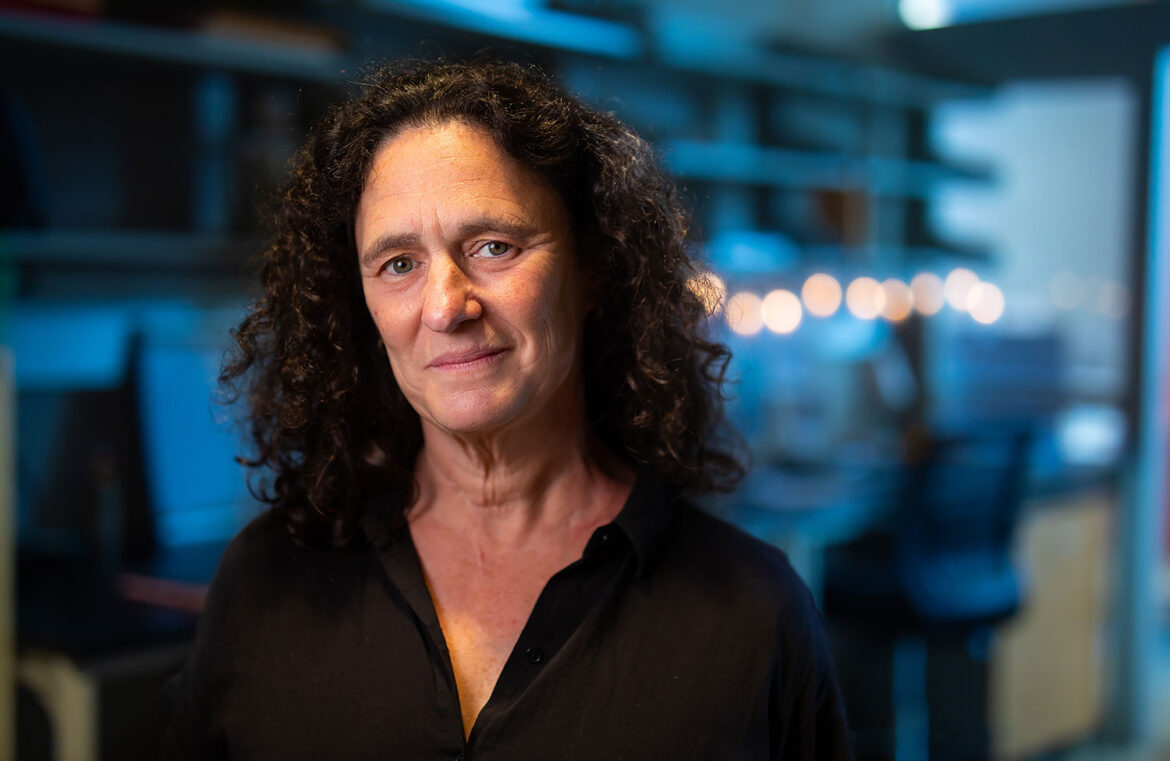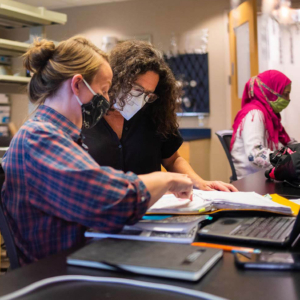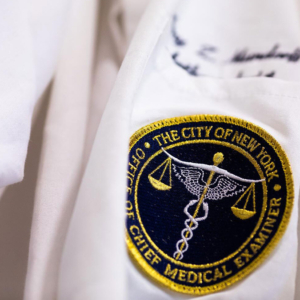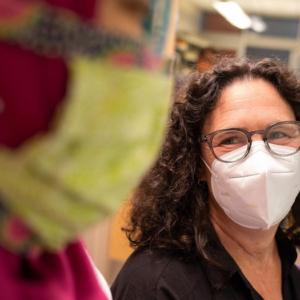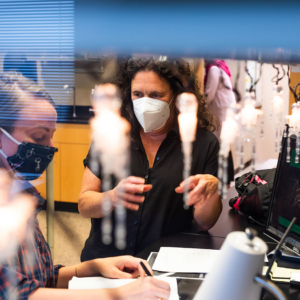Professor Amy Mundorff identified human remains after the World Trade Center attacks on 9/11. At UT, she produces groundbreaking research and mentors a new generation of forensic anthropologists.
Amy Mundorff couldn’t have stayed home. Not after what had happened.
Two days earlier, on September 11, 2001, two hijacked Boeing 767 airplanes had flown into the towers of the World Trade Center. Mundorff, who was New York City’s first full-time forensic anthropologist, was sent to the site to assess the situation after the second plane struck the south tower at 9:03 a.m. Fifty-five minutes later, when the south tower collapsed, she was buried underneath the debris.
Mundorff still bears the scars of the tragedy: compression fractures in her neck, a brain injury a neurologist compared to those found in service members who experience IED blasts, and a disease in her lungs from the ash and rubble that filled them as she fought to escape.
“I was in so much pain,” says Mundorff, now an associate professor of anthropology at the University of Tennessee, Knoxville. “And I couldn’t process what I saw. The sounds of the collapse. The chaos. The smell was in my head. The faces of the missing—their photos were plastered everywhere.”
With two black eyes, Mundorff reported to work on September 13. At a table beside firefighters, police officers, and FBI agents who had lost partners in the attacks, she got to work identifying the dead.
For the next three years, Mundorff and her colleagues in the New York City Medical Examiner’s Office undertook the country’s most complex and labor-intensive process of identifying human remains. By the time she left the project in 2004, they had identified 1,480 of the 2,749 victims.
Her determination—to find answers, to help families know what happened to the ones they lost—has never left her. After Mundorff completed her PhD in Canada in 2009, Forensic Anthropology Center Director Dawnie Steadman, then at Binghamton University in New York state, pointed her toward a job opening at UT. Hired soon afterward, Mundorff, who was emerging internationally as an expert in victim identification and mass fatality management, would conduct her research at the FAC.
“This was literally the one place in the world I could do practical research that was related to all the work I’d done before in the field of forensics,” Mundorff says.
Firsts in Forensic Science
In the decade she’s been at UT, Mundorff continues to push the field of forensic science forward. Within a month of joining the university she pitched her first major project: to test every bone in the human skeleton to see which yield the best DNA for identifying human remains.
It had never been done before.
The idea for the project, which was funded by the National Institute of Justice, had its origin in Mundorff’s work identifying human remains after 9/11. She had discovered that many of the best DNA yields were coming not from weight-bearing long bones like the femur—the largest bone in the body and the one that forensic anthropologists had traditionally been instructed to sample—but from smaller bones in ankles, kneecaps, fingers, and toes.
“People thought I was nuts,” Mundorff says. “But I read all the literature. The idea that weight-bearing long bones were the best for extracting DNA came from nowhere. It was completely anecdotal.”
Mundorff’s other research has resulted in similar firsts for the field. She has used spectral imaging, a form of chemical imaging through visual reflectance of light, to indicate when decomposing bodies affect the surrounding soil and vegetation. She has taken thermal readings at the center’s Anthropological Research Facility—commonly known as the Body Farm—to see how bodies, which warm during decomposition, stick out amid the cooling soil. She is working on a project that combines multiple remote sensing technologies such as lidar and hyperspectral imaging to locate clandestine graves.
In 2015, Mundorff began work with Thomas Parsons, the now-retired director of forensic science for the International Commission on Missing Persons, on a new method to collect postmortem samples following a mass disaster. Funded by the NIJ, the work was inspired by a conversation she had with Parsons following the 2010 earthquake in Haiti that claimed more than 200,000 lives.
“At that time, there was no infrastructure, no refrigeration, no medical experts, no food or water, even, and bodies were just being buried in mass graves with no identification for the families,” Mundorff says. “We thought there had to be a way to at least collect DNA quickly and efficiently before decomposition.”
Mentoring the Next Generation
In August 2016, Mundorff was taking samples at the Body Farm for her project with Parsons when her two incoming master’s students arrived on campus.
Neither Megan Kleeschulte, of Vernon, New Jersey, nor Jenna Watson, of Vancouver, Washington, had ever seen a dead body before. Mundorff asked, “Do you want to help me with a project I’ve got going on?” Soon both women were at the farm slicing muscle tissue from a bloated body—a process they repeated every eight hours for two weeks.
“That very first experience with her definitely set the tone,” says Kleeschulte, who summarizes Mundorff’s approach as You don’t know how to do this? That’s cool. I’ll show you. “She just wants us to learn,” she says. She and Watson both completed their master’s degrees in 2018 and are working toward PhDs under Mundorff.
The policy-related research that came out of Mundorff’s work on 9/11—the best practices for DNA identification, the unforeseen issues they faced—was what most interested Kleeschulte. She wrote her master’s thesis on the repatriation of Native American remains and artifacts through the National American Graves Protection and Repatriation Act, or NAGPRA. In one of their early conversations, Mundorff had mentioned to Kleeschulte that, while in the medical examiner’s office in New York, she had received Native American remains that likely ended up stored away on a shelf somewhere. No one knew what to do with them.
That story inspired Kleeschulte, who sought to identify where indigenous remains were located nationwide, to build a national database for medical examiner’s offices and tribes, and eventually have remains returned where they belong. The research was awarded a grant by the NIJ, which is funding Kleeschulte’s PhD research.
“When I started with NAGPRA, that was really outside of Amy’s normal wheelhouse,” Kleeschulte says. “Sometimes with student–advisor relationships, you might have an advisor steer you toward a research line that fits in their own. Amy isn’t that way. She’s very supportive of you blazing your own trail.”
Watson, who leaves in October on an eight-month Fulbright grant to study human remains from cemetery sites in Romania in order to understand migration, mobility, and health of people living in that area during the 14th to 18th centuries, also credits Mundorff’s support, both inside and outside of the classroom, with getting her to where she is in her career so far.
“Amy advises you on the academic side,” Watson says. “But she also understands that we’re people who have lives outside of the department. She doesn’t expect us to be perfect or to not need help. Having someone to support you personally and professionally like that is priceless.”
Working for the Families
This September 11 marks 20 years since the day Mundorff was called to the World Trade Center site.
Two years ago, she gave a campus lecture about her work helping to identify victims from the more than 20,000 human fragments recovered in New York from that day. Many of the students in attendance hadn’t been born when the tragedy occurred.
But Watson knew what Mundorff had been called to do. Before starting her master’s degree at UT, Watson worked with Physicians for Human Rights in New York City, where another of her mentors was a medical examiner who had told her about his work with Mundorff to make the identifications after 9/11.
Watson first heard Mundorff tell her version of the story during one of her classes. Recounting her experience of being sent to the towers, showing up to work two days later, and giving three years of her life to what came afterward, Mundorff emphasized something about first responders that Watson still remembers: You have a job to do. But you don’t have to act strong or like everything is OK all the time. It’s OK not to be OK.
“If there’s anything in my life I could change, it would be the decision I made to go to the World Trade Center after the second plane hit,” Mundorff says. “I tell all my students: as forensic anthropologists, we deal with the dead. We can wait until the scene is secure. You never know what can happen to you.”
For now, Mundorff continues to make an impact through her research. Currently she is working with doctoral candidate Armando Anzellini on a new triage method to determine the limits of extracting DNA from bodies that have been severely burned. It may not help provide positive IDs on the 1,106 victims of 9/11 who remain unidentified. But it will move forensic science forward to provide answers for families of others who are dead or missing.
The end game is not closure. “That’s not the work of the scientist,” Mundorff says. The role of the forensic anthropologist—what Mundorff teaches her students to dedicate their careers to—is providing information for the living.
“Everything we do is for them,” Mundorff says.

